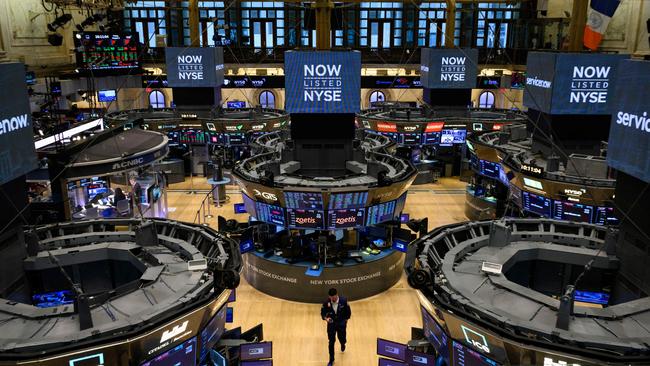Victory over inflation? The figures just don’t stack up
Forget the narrative the US sharemarket rose and Australia followed because recession risks supposedly eased and US quarterly earnings held up well. The bond market says otherwise.

A positive week for risk assets came as lower-than-expected US inflation data fuelled expectations that the Fed won’t lift rates as much as officials previously indicated.
But for markets which saw big gains in the two months leading up to the US CPI and PPI numbers this week, the question is whether those should be extended – or were even fully warranted – after US inflation data which were still unacceptably high, albeit lower than expected.
After falling almost 25 per cent from a record high in January, the S&P 500 is almost 16 per cent above its June low, while the Nasdaq Composite is 21 per cent above an equivalent trough and supposedly back in a “bull market”, according to technical analysts.
Australia’s ASX 200 bounced about 10 per cent in the same period but lost momentum Friday amid a jump in bond yields.
A plunge in the all-important 10-year US Treasury yield – referenced as the “risk free” rate used in discounted cashflow valuations for shares globally – led the surge in the US market.
The 10-year yield dived from a decade high of 3.5 per cent in mid June to a 3½-month low of 2.51 per cent by early August.

And in an important recession warning, the slope of the US yield curve, measured by the 10-2 year Treasury bond spread, flattened to its most negative point since 1982 – near minus 50 basis points.
So forget the narrative that the US sharemarket rose and the Australian market followed because recession risks supposedly eased and US quarterly earnings – which by no means fully reflect the impact of rate hikes so far and rate hikes plus quantitative tightening to come – held up well.
The two-month bounce in shares was all about “bad news is good news” for US monetary policy. And while the US market kept rising this week, the bond market began to question whether the US economy would actually cool as easily as the sharemarket has been hoping.
July non-farm payrolls – a lagging indicator – rose more than twice expectations last Friday.
The trouble is the Fed may not have the luxury of stopping rate hikes and cutting as soon as the market now expects without fuelling a damaging rise in inflation expectations.
Reflating the bubble is only a “last resort” policy for the Fed and other central banks.
We’re not there yet, not without another financial crisis.
After last week’s US jobs data, the US 10-year bond yield hit a three-week high of 2.90 per cent and the yield curve “bear steepened”, with the 10-2 year Treasury bond spread rising to minus 32 basis points. In other words, the bond market didn’t see reason to expect less rate hikes post-CPI.
“The interest rate market is clearly not drinking the same post-CPI cool-aid that the equity market has slugged on,” said City Index chief market strategist Tony Sycamore.
Interestingly, San Francisco Fed president Mary Daly gave two interviews on Thursday to the effect that it’s too early to declare victory on inflation. Her interviews followed similarly hawkish comments from FOMC members Kashkari and Evans.

AMP Capital chief economist Shane Oliver said it was “premature” to celebrate victory over inflation.
US goods price inflation has slowed and is likely to fall further – reflecting rising inventories, lower delivery times and falling freight rates – and energy inflation may have peaked but services inflation is still trending up reflecting rising labour costs, which are “more sticky”, Oliver says.
That was reflected in the increasing breadth of price rises with the median inflation rate rising to a new high of 6.3 per cent year-on-year and the proportion of CPI components with price gains above 3 per cent year-on-year up to 89 per cent.
Increasing evidence of a peak in US inflation was consistent with AMP’s Pipeline Inflation Indicator, which is still pointing to further falls in inflation.

The better US inflation news along with signs inflation expectations are being contained will likely enable the Fed to “go a bit easier” in the months ahead, possibly hiking 0.5 per cent in September rather than 0.75 per cent.
The US led other countries in the inflation blowout, so the cooling in US inflation is a positive sign for Australia and a potential peak next quarter would be consistent with a six-month lag to the US, according to Oliver.
But he said it would take a while to get inflation back to target, so more rate hikes from the Fed lie ahead, and shares remain “vulnerable to a pullback”.
He noted central banks were long way from peaking and actually cutting rates – recession risk is still rising and this runs the risk of significant earnings downgrades; and geopolitical risk is on the rise with the escalation in China/US tensions over Taiwan and the upcoming US midterm elections.
But with markets rebounding after having already anticipated a mild recession Oliver saw a “possibility that we may have seen the bear market low and any pull back may just be a partial retracement of the rally since mid-June”.
“Either way, on a 12-month horizon we remain optimistic on shares as inflation recedes, central banks become less hawkish and at least a deep recession is likely to be avoided.”




To join the conversation, please log in. Don't have an account? Register
Join the conversation, you are commenting as Logout